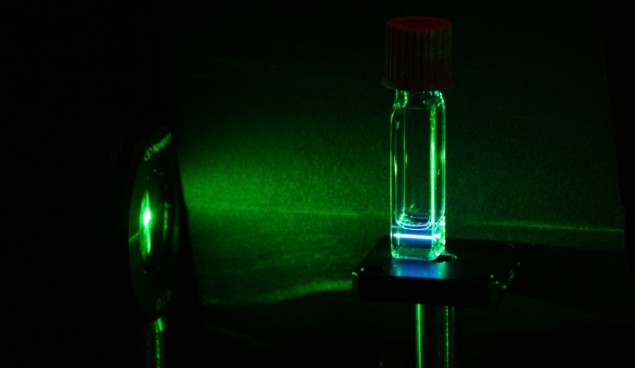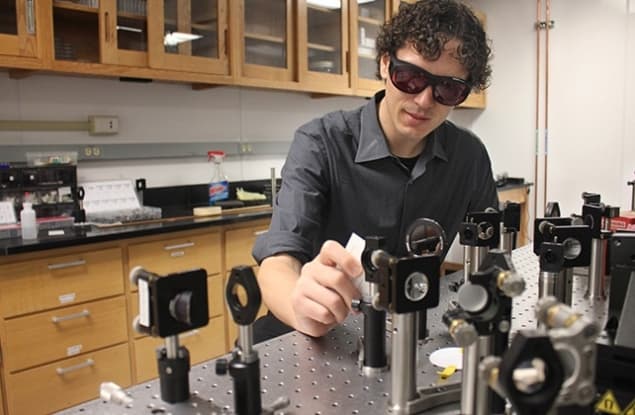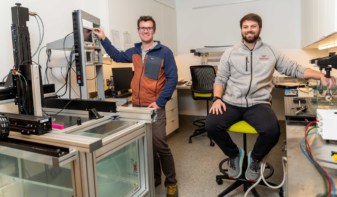
Researchers in the US have designed non-toxic silicon nanocrystals functionalized with specialized organic molecules and shown that these materials can readily combine low-energy photons into higher energy ones. This process, known as photon up-conversion, can address several key problems in biology and materials science (Nature Chemistry 10.1038/s41557-019-0385-8).
Recent advances in deep-tissue imaging and phototherapy for cancer treatment have been transformative. Such technologies mainly use near-infrared (NIR) light, which has a higher penetration depth through biological tissue than ultraviolet or visible light. However, as NIR light contains low-energy photons, it may not have enough energy to generate the free radicals needed to kill nearby abnormal cells.
As such, material scientists and chemists have been working to convert low-energy NIR photons to high-energy excited states, using functionalized inorganic nanocrystals (NCs) containing energy-accepting dyes. It is possible to achieve light up-conversion with efficiencies of more than 10% using such materials. However, the NCs employed contain toxic heavy elements, such as lead, which limits how they can be used.
Non-toxic design
To overcome these shortcomings, material scientists at the University of California, Riverside and the University of Texas at Austin – led by Sean Roberts, Lorenzo Mangolini and Ming Lee Tang – replaced the toxic NCs with non-toxic silicon infrared absorbers. Using silicon NCs to upconvert photons holds promise for their application in medicine, to generate light that can penetrate far enough into biological tissue and have high enough energy to generate the therapeutic radicals.

In the new design, the researchers employed nanocrystal-to-molecule triplet energy transfer to achieve photon up-conversion. The silicon NCs absorb 488–640 nm photons and produce excited electron–hole pairs (excitons). These excitons then transfer their energy to 9,10-diphenylanthracene (DPA) molecules in solution. As a result, the DPA molecules are excited to a spin-triplet exciton state (in which one electron is excited to a higher energy level than the ground state and its spin is no longer paired with the ground-state electron).
The newly synthesized silicon NCs are functionalized with organic molecules such as 1-octadecene, or a combination of 1-octadece and 9-vinylanthracene that becomes 9-ethylanthracene (9EA) upon attachment. The researchers chose DPA as it exhibits high (above 97%) fluorescence emission. By carefully studying the surface chemistry of the silicon NCs, the researchers learned how to attach surface ligands, enabling them to functionalize the silicon NCs with organic molecules such as 9EA.
To test their technique, the researchers shone laser light into a solution containing silicon NCs and DPA molecules. The silicon NCs absorbed laser light and transferred the energy through the 9EA molecules to DPA in solution in the form of high-energy photons: 425 nm (violet) light. “We got higher-energy light!” says co-first author Pan Xia.
The principle behind this higher-energy output relies on the use of quantum confined nanoparticles and the ability to hold the nanoparticles (silicon NCs) and organic molecules (9EA) close enough together to take advantage of the triplet state of the surrounding molecules.

“The challenge has been getting pairs of excited electrons to transfer between silicon and organic materials. It cannot be done just by depositing one on top of the other,” says Roberts. “It takes building a new type of chemical interface between the silicon and this material to allow them to electronically communicate.”
As well as medical applications, the authors believe that the new silicon NCs also hold promise for use in up-conversion photocatalytic systems and quantum information science. “Photocatalysts generally only work with ultraviolet or violet light, so this is a way to generate that from the rest of the solar spectrum,” Tang says.



